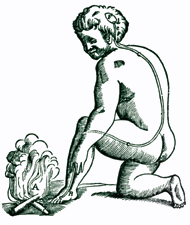| Nature 402, 353 (1999) © Macmillan Publishers Ltd. |
Two millennia of animal spirits
IAN GLYNN
>Ian Glynn is at
Trinity College, University of Cambridge, Cambridge CB2 1TQ, UK.
An ancient theory about nerves proved surprisingly hard to dislodge.
I think it was E. D. Adrian who said that in many lines of research there are two crucial steps. The first is to find the right question; the second is to find the right answer to it. Sometimes the interval between the two is quite short. Having asked why the apple fell, Newton didn't take long to produce the theory of gravitation. But the interval between asking and answering what passes along nerves that enables them to produce their effects was more than two millennia.
 |
| The body hydraulic: Descartes' illustration of the sensory path of burning pain. |
It was Alexandrian physicians of the third century BC who first asked the question about nerves, and they also attempted an answer. It was, they said, the flow of animal spirits along motor and sensory nerves that led to movement and sensation. As animal spirits (pneuma psychikon in Greek; spiritus animalis in Latin) were thought of as weightless, intangible and invisible, to say that nerves produced their effects by a flow of such spirits was to say little more than that something undetectable was passing along the nerves — which was of course true. But that doesn't explain why a theory that was neither testable nor helpful survived until the seventeenth century ad. Its survival was the result of its espousal, in the second century ad, by Galen — not so much because of his impressive contributions to physiology and medicine, as because his belief in a single, all-wise, all-just God or Creator made his medical writings almost canonical throughout the Christian and Muslim worlds.
By the seventeenth century, ad hoc, incorporeal spirits had reached their 'best before' date. Descartes regarded animal spirits as a real fluid, and compared the actions of nerves — which he believed contained valves — to the action of the hydraulic pipes controlling machinery in the royal gardens. He said it was the distension of muscles by an inflow of animal spirits that caused them to shorten. But nerves don't contain valves, and Jan Swammerdam, in Amsterdam, showed that muscles don't increase in volume when they shorten. Giovanni Borelli, professor of mathematics at Pisa, rejected the idea that any substance passes along nerves and suggested that what is transmitted is "a commotion". Nerves, he said, were "canals filled with spongy material like elder-pith ... moistened with the spirituous juice of the brain ... and saturated to turgescence", so they could transmit a "concussion or undulation". The basic notion of a transmitted commotion was right; the colourful analogy of concussion through a column of fluid was not. Discovery of the nature of the commotion had to await an understanding of current electricity — the work of Luigi Galvani, Alessandro Volta and Michael Faraday.
In the middle of the nineteenth century, in Berlin, Emil Du Bois Reymond showed that the voltage across the surface membrane of an inert nerve fibre — the resting potential — was transiently diminished when the fibre was stimulated. What is more, the fall in the transmembrane voltage — the action potential — occurred first at the point of stimulation and spread in both directions along the fibre. Could the action potential be the message that the nerve transmitted? If it were, the message and the action potential would necessarily travel at the same speed. In 1850, Hermann Helmholtz stimulated the nerve of a frog muscle at different distances from the muscle and compared the delays before the muscle contracted. He calculated that the speed of the message that initiated contraction was about 27 metres per second. Eighteen years later, Julius Bernstein, a former pupil of both Du Bois Reymond and Helmholtz, overcame difficulties caused by the great inertia of the galvanometers of the day and showed that the speed of the action potential was not significantly different.
Why should the action potential move along the nerve? In the last year of the nineteenth century, Ludimar Hermann, in Königsberg, pointed out that, at the junction of active and resting regions of the nerve, local electric currents would tend to reduce the voltage across the membrane adjacent to the active region. If this reduction excited that adjacent region, local currents would again be generated, exciting the next bit, and so on. In other words, the action potential would be propagated along the nerve.
The twentieth century, and particularly the work of Alan Hodgkin and of Andrew Huxley, would prove Hermann's hypothesis, would show that the action potential involves not just a diminution but also a change in sign of the voltage across the nerve membrane, would explain how the subtle behaviour of voltage-sensitive channels selective for sodium or potassium ions gives rise to the resting and action potentials, and would begin to relate that subtle behaviour to the molecular structure of the channels. But all that is another story, which started only after animal spirits had been thoroughly exorcised.
![]()